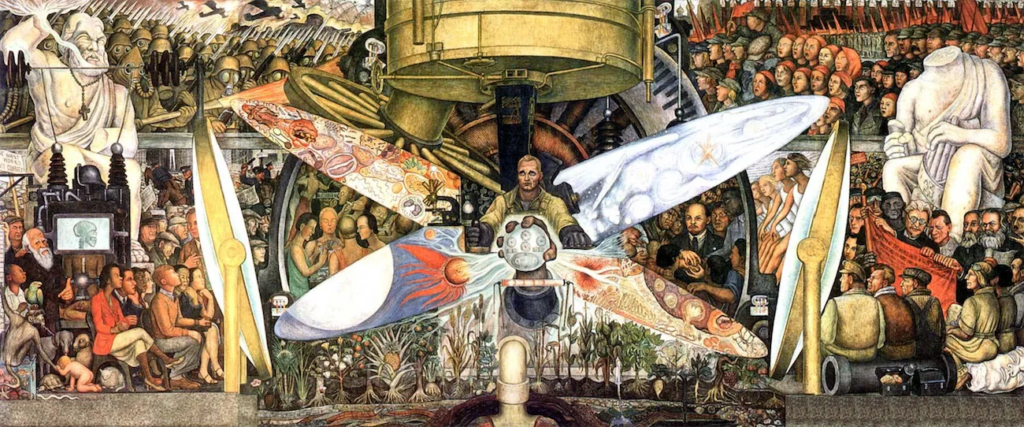
Diego Rivera: Pillar of Mexican Art in the World
Panorama of Mexican art: From the pre-Hispanic to the contemporary
The history of Mexican art is rich and varied, expansive in both its temporal corset and its cultural diversity. From fascinating pre-Hispanic creations to contemporary manifestations, the essence of Mexico has been captured in each brushstroke and carving, communicating an ethos that transcends time. The artistic heritage of this country is not only enriched by the plasticity of its forms, but also by the deep symbolism and history that each work houses.
Rivera's role in the history of Mexican art
In the Mexican artistic torrent, Diego Rivera emerges as a central figure, whose work not only reflects the core of Mexican identity, but has also played a crucial role in shaping and defining the canon of his art. Rivera's paintings, recognized worldwide, draw a visual account of struggle, hope and daily life in Mexico, while opening a continuous dialogue about its pre-Columbian past and its post-revolutionary reality.
Relationship between Rivera's work and Mexican cultural identity
Considered one of the great muralists of the 20th century, Diego Rivera captured more than aesthetic images in his murals; He projected fundamental aspects of the human condition embedded in an emerging postcolonial Mexico. His works are mural stories that not only speak of history and social challenges, but also encapsulate the robust and vibrant Mexican cultural identity. Each Rivera mural is in itself a dialogue, not only with the contemporary viewers of its time, but with future generations, hence its relevance in the international art scene.

Rivera's work is a crucible of Mexican history
His murals are a visual discourse on identity and culture
Diego Rivera, an artist who dialogues with the future from the past
Source




- April 15, 2025
Gallery Of Painting By Matt Rota - USA

- April 15, 2025
Gallery Of Illustration By Egle Plytnikaite - Lithuania

- April 15, 2025
Gallery Of Humor Drawing By Pierre Ballouhey - France

- April 14, 2025
Gallery of Illustration by Ananda Ferreira – Brazil


- April 14, 2025
Gallery of Illustration by Luis San Vicente – Mexico

- April 14, 2025
Analysis of Artistic Works Created with…

- April 13, 2025
From Digital Art to Contemporary Art

- April 13, 2025
The Expansion of Photography

- April 12, 2025
When is photography considered art?

- April 10, 2025
Impact of AI on the Diversity of Artist…

- April 10, 2025
How can AI enhance artistic creativity?

- April 09, 2025
The Impact of Artificial Intelligence o…

- April 08, 2025
Latin American art, a goldmine of oppor…

- April 07, 2025
Contemporary Art in Brazil: Between the…

- April 07, 2025
Mexican Muralism: Art for the People

- April 06, 2025
History of graphic art in Brazil

- April 05, 2025
Modern Art: A Renaissance in Art History

- April 02, 2025
Aldo Estrada (Ilustronauta): From Peruv…

- March 31, 2025
How ChatGPT is Turning Photos into Japa…

- March 30, 2025
Arístides Hernández (ARES): A Sharp Min…

- March 30, 2025
The Masters of Cuban Caricature: Celebr…

- March 29, 2025
Where Will Artificial Intelligence Take…

- March 27, 2025
A Few Fascinating Features of Latin Ame…

- March 27, 2025
9 Key Books to Understand Latin America…

- March 26, 2025
The Underground: A Glimpse into 1930s L…

- August 29, 2023
The history of Bolivian art

- February 19, 2024
Analysis and meaning of Van Gogh's Star…

- January 28, 2024
Culture and Art in Argentina

- September 25, 2023
What is the importance of art in human …

- September 23, 2023
What is paint?

- August 30, 2023
First artistic manifestations

- August 10, 2023
14 questions and answers about the art …

- August 23, 2023
The 11 types of art and their meanings

- March 26, 2024
The importance of technology in art1

- August 16, 2023
The 15 greatest painters in art history

- September 23, 2023
History of painting

- April 06, 2024
History of visual arts in Ecuador

- January 20, 2024
What is the relationship between art an…

- March 26, 2024
Cultural identity and its impact on art…

- January 31, 2024
Examples of Street Art – Urban Art

- October 21, 2023
Contemporary art after the Second World…

- September 23, 2023
Painting characteristics

- August 25, 2024
A Comprehensive Analysis of the Cartoon…

- April 07, 2024
Graffiti in Latin American culture

- March 05, 2024
The art of sculpture in Latin America

- February 19, 2024
Analysis and meaning of Van Gogh's Star…

- August 13, 2023
9 Latino painters and their great contr…

- August 29, 2023
The history of Bolivian art

- August 10, 2023
14 questions and answers about the art …

- January 28, 2024
Culture and Art in Argentina

- August 23, 2023
The 11 types of art and their meanings

- November 06, 2023
5 Latin American artists and their works

- September 23, 2023
Painting characteristics

- August 27, 2023
15 main works of Van Gogh

- September 23, 2023
What is paint?

- September 25, 2023
What is the importance of art in human …

- August 30, 2023
First artistic manifestations

- January 20, 2024
What is the relationship between art an…

- December 18, 2023
10 iconic works by Oscar Niemeyer, geni…

- January 12, 2024
10 most beautiful statues and sculpture…

- October 30, 2023
Characteristics of Contemporary Art

- March 26, 2024
Cultural identity and its impact on art…

- August 22, 2023
What are Plastic Arts?

- April 16, 2024
The most important painters of Latin Am…

- October 11, 2023


